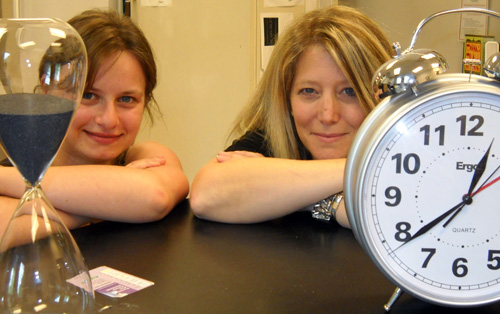
Doctors need clockwork to treat heart disease, say U of G researchers who have found genetic evidence for considering time of day – or night – in diagnosing and treating heart patients.
Prof. Tami Martino, Biomedical Sciences, and PhD student Elena Tsimakouridze have pinpointed a handful of “timekeeping” genes linked to heart disease. Their first-ever study comparing gene expression in healthy and diseased hearts over a 24-hour-period involves both genomics and time, or so-called “chronomics.”
Tsimakouridze is lead author of the study to be published this summer in the journal Chronobiology International.
Scientists already knew that heart genes cycle periodically, leading organs to make greater or lesser amounts of critical proteins. That activity is governed by molecular “clocks” in body tissues running on a 24-hour circadian cycle.
Says Martino: “The body’s ‘master’ clock resides in the brain, and the peripheral clocks exist in the heart and all other organs to co-ordinate our physiology to the external environment.”
The system is triggered by various cues, mainly light but also food.
She studies circadian rhythms, or day-night cycles, and their role in heart patients. Last year, she and other researchers made headlines with a study showing heart drugs called ACE inhibitors work best at night rather that during the day.
For this new study, she and her grad student followed heart gene activity over 24 hours. They compared normal mouse hearts with hearts that mimicked the effects of hypertensive heart disease.
Not only did they see physical changes in the diseased hearts, but they also spotted patterns of activity in about a dozen genes linked to heart metabolism and structure.
Their study required them to comb through gene arrays to find changes in expression of pertinent genes over time, an approach called chronomics. “Nobody else has done this. We had to write a software program,” says Martino, adding that they enlisted a University of Virginia biologist for help with biocomputing and analysis.
The Guelph professor hopes doctors will ultimately use this information to better detect and treat diseases.
A physician might schedule a diagnostic test for the time of day when a particular enzyme is supposed to peak in a patient with high blood pressure. “What time of day you get the test can tell what kind of disease you have.”
Or doctors might refine treatment based on time of day, called chronotherapy.
Doctors might also use this information in treating other ailments, including tumours, says Martino. “Cancer also has a circadian rhythm.”
Tsimakouridze presented their work this spring to members of the International Society for Heart Research in Alberta. She also accepted a PhD poster award at this year’s Muscle Health Awareness Day held by the health faculty at York University.
She came to Guelph in 2010 for grad studies. During her undergrad at the University of Toronto, she had worked with Martin Ralph, director of the Centre for Biological Timing and Cognition.
She also worked at a Toronto sleep clinic; conditions such as sleep apnea are known to be linked to heart disease.
At high school, Tsimakouridze competed in national chess tournaments (she had begun working with her first chess coach at age 5). Today she volunteers with TEDx Waterloo and manages the website of a research group involving Martino and five other U of G scientists in heart studies (www.uoguelph.ca/CardiovascularResearch/index.html).